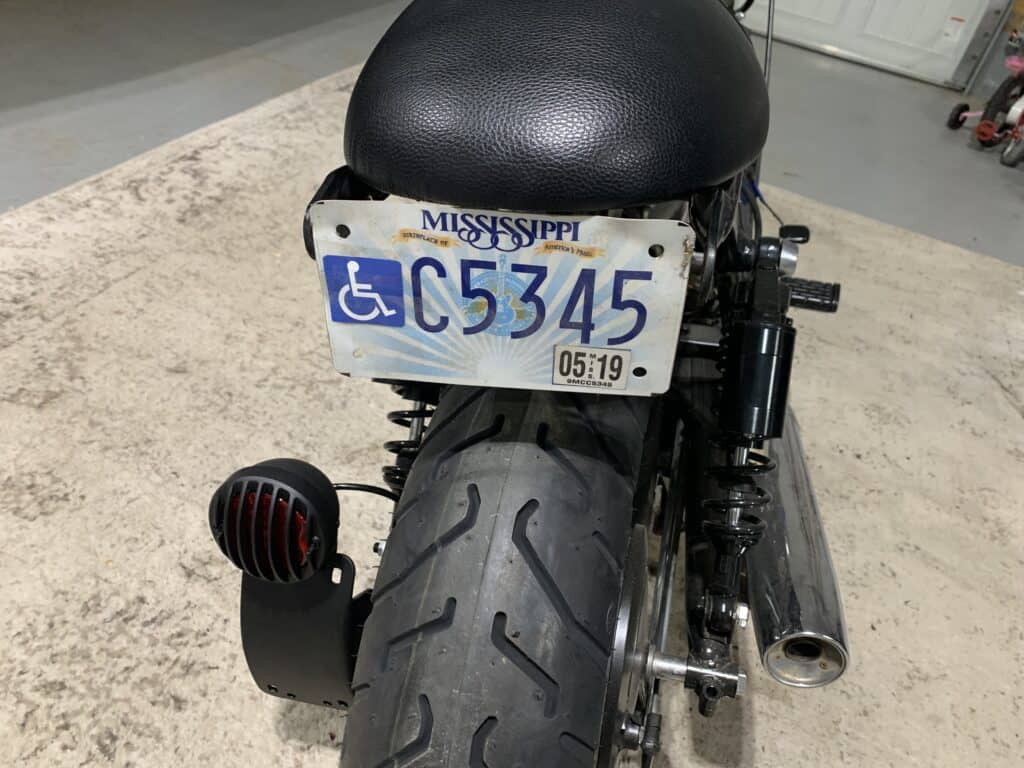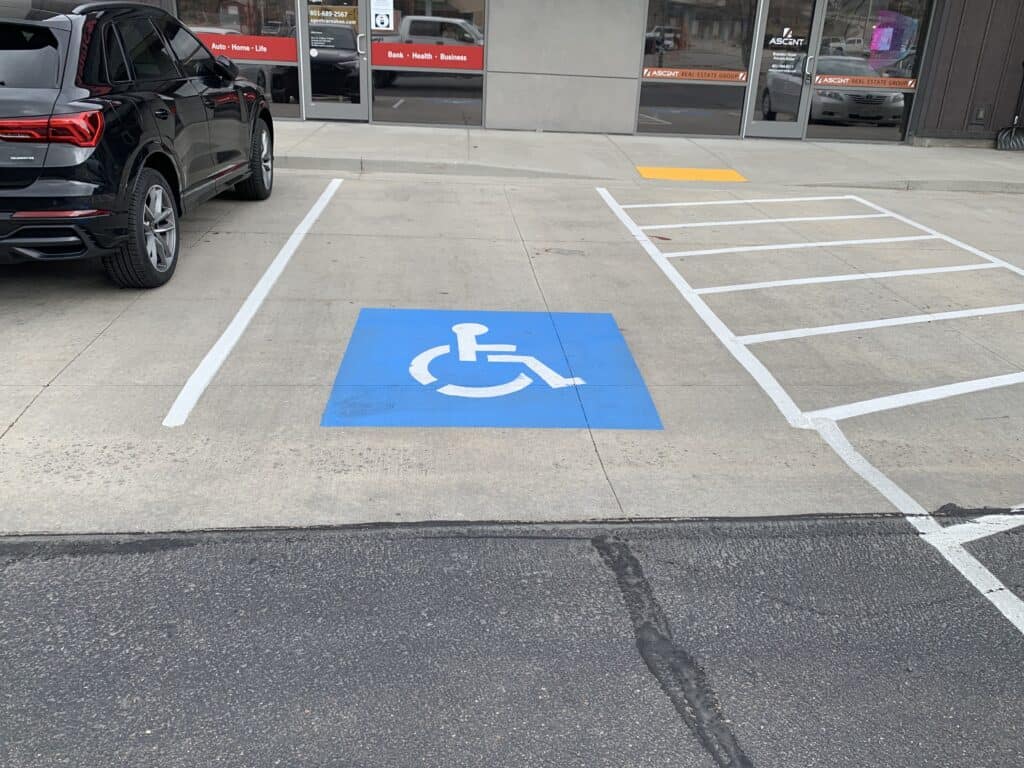
Handicap plates, handicap stickers, and disabled permits are a privilege that is often misunderstood by most motorists that have never had to use one. Most of us just know that if you see that handicap symbol anywhere on the car, they get the best parking spots in the parking lot.
Whether you’ve seen a motorcycle with handicap plates or you’re a motorcyclist wondering if you can get them, it’s a question that should be answered to help people better understand how this works.
Can motorcycles have handicap plates? It is completely possible and permissible for a motorcycle to have handicap plates and a disabled parking permit. Depending on the disability, it is still feasible for a disabled person to ride a motorcycle and still require the benefits of disabled parking.
At first it may seem odd that this is even a possibility. I have come into contact with several people who have had handicap plates on their motorcycles. I’ll explain what I’ve learned and why it’s legal.
Why Motorcycles Can Have Handicap Plates
Most people assume that motorcycles are more dangerous and more difficult to ride, so those who have disabilities should not be riding them. To set things straight, it isn’t that difficult to ride a motorcycle. In fact, it’s really not that much more difficult to ride one compared to driving a car after you’ve learned how to do it.
The word “handicap” and “disabilities” can entail a whole slew of things. Most assume that they’re physical disabilities that keep you from walking or performing major activities throughout your day by yourself. While these words do entail these types of people, it’s a lot more than just that.
A lot of people have a “handicap” or “disability” that cannot be seen. Such things may include:
- Breathing issues with limited walking lengths
- Chronic pain
- Arthritis
- Organ transplant
- Cardiac conditions
- Hidden prosthetics
- Seizure disorders
Having a handicap plate and disability parking permit on a car is commonly accepted by most people. But you’ll see people fret about the fact that it’s on a motorcycle. The truth is, if the person has a disability but is capable of driving a car, they’re also capable of riding a motorcycle as well. Having shortness of breath or an organ transplant doesn’t hinder your abilities to operate a motorcycle.
If there was any reason a person could not physically operate a motorcycle, they would not be permitted to operate a car either. The only risk involved on a motorcycle is the rider getting more injuries in the case of an accident, which is already a risk involved whether or not you have a disability.
Motorcycles can also get handicap plates or a disability parking permit because of passengers. Just like other motorized vehicles, a motorcycle can carry a person with disabilities granted it has adequate room. The driver themselves do not have to have the handicap or disability as long as their passenger is defined as “disabled.”
The Handicap Tags A Motorcycle May Have
There are many forms of handicap tags, stickers, and permits a motorcycle can have. So if you don’t see one right away but see the motorcycle parked in a handicap spot, don’t be too quick to judge. Depending on the fee that is paid and the type of disability the driver or passenger has, the stickers or tags will come in different forms.
The first and most obvious one will be the blue and white symbol found on the license plate. Motorcyclists can get these either temporarily or permanently, depending on the type of disability they have. For the permanent plates, the rider must fill out a form with a signed doctor’s note validating the disability and pay a one time fee (but will continue paying regular annual registration fees for the vehicle).
If the disability of the motorcycle rider is temporary, the rider will need to fill out a new form and submit a new doctor’s note every six months or so. You’ll also need to pay an additional fee.
Motorcycles may also have a disabled parking permit found somewhere on their motorcycle. These are also knows as an “extra placard.” These are the ones you usually see hanging on the rear view mirror of cars. Motorcyclists have to get a little creative with where they put these.
These are usually supplied to the rider in addition to the permanent handicap plates they get. Their intended use is for additional vehicles they drive that doesn’t have the handicap plates on them (such as a motorcycle). These need to be renewed every two years. It’s also possible to get these with temporary handicap plates, but these also require a renewal process
Motorcyclists often have to be careful with placards because they’re a common target for theft. Apparently, some people are willing to pay a lot of money for them so they can get better parking spots (which seems extreme and a little lazy to me). When a motorcyclist simply leaves the placard hanging on their handlebar, they risk someone taking it.
The handicap license plate is usually nothing to worry about because those are fastened to the motorcycle. Motorcyclists will sometimes either tape the permit on their windshield or fasten a plastic casing somewhere on their motorcycle that can hold the permit to make it more difficult to take.
Can Motorcycles Park In Handicap Spots?

The next question people have is if whether or not a motorcycle can park in handicap spots. The simple answer is that if a motorcycle has a handicap license plate and/or disabled parking permit, they can absolutely park in a handicap spot.
A lot of people get annoyed with this because a motorcycle is a lot smaller than a car. The fact that they take up a whole space where a car could park seems irrational. But it’s actually completely legal if the motorcycle has the right tags. In the end, the parking spot is serving it’s purpose in helping the disabled person park closer to wherever they’re going. Whether or not it’s a car or a motorcycle that took them there is irrelevant.
If a motorcycle does not have the appropriate license plate or tags to enable them to park in handicap spots, then it’s completely illegal. You may have noticed some motorcycles parked on the striped lines in parking lots which is also illegal whether or not they have a handicap plate. For more information about motorcycles parking on striped areas, see my article here.
Other Privileges Of Motorcycle Handicap Plates
Along with being able to park closer to a business, motorcycle handicap plates enable several other privileges as well. U.S. and state laws have tried to make it easier for those with disabilities to get around and eliminate some of the obstacles they may encounter.
The first and most obvious privilege is parking anywhere that has a handicap symbol. This may mean a curbside, parking spot, or specially designated area for those with disabilities.
The second privilege of handicap plates on a motorcycle could also mean that you can park in metered parking without having to pay. Not everywhere follows this rule, but I’ve seen it more often than not.
The third (and pretty awesome) perk of having a handicap plate on your motorcycle is that in some states you can have an employee fill up your tank for you at a gas station at no extra charge. This is meant for those who truly need it. If you have a handicap plate on your motorcycle but are still completely capable of filling up your own gas, then please do it yourself.
Conclusion
As odd as it may sound, it is completely possible for a motorcycle to have handicap plates. Many disabilities are not seen and do not impact an individual’s ability to ride a motorcycle but still require the benefits of these type of plates.
As advocates continue to push for inclusivity and accessibility in transportation policies, it will be interesting to see how the access of motorcycle handicap plates will evolve in the future. I know this can be a controversial subject for some, so let me know what your thoughts are!
Related Question
What does a red handicap sticker mean? A red handicap sticker is a placard indicating that the driver or passenger has temporary access to handicap parking. Their condition that deems them “disabled” is expected to improve within the next few months.
